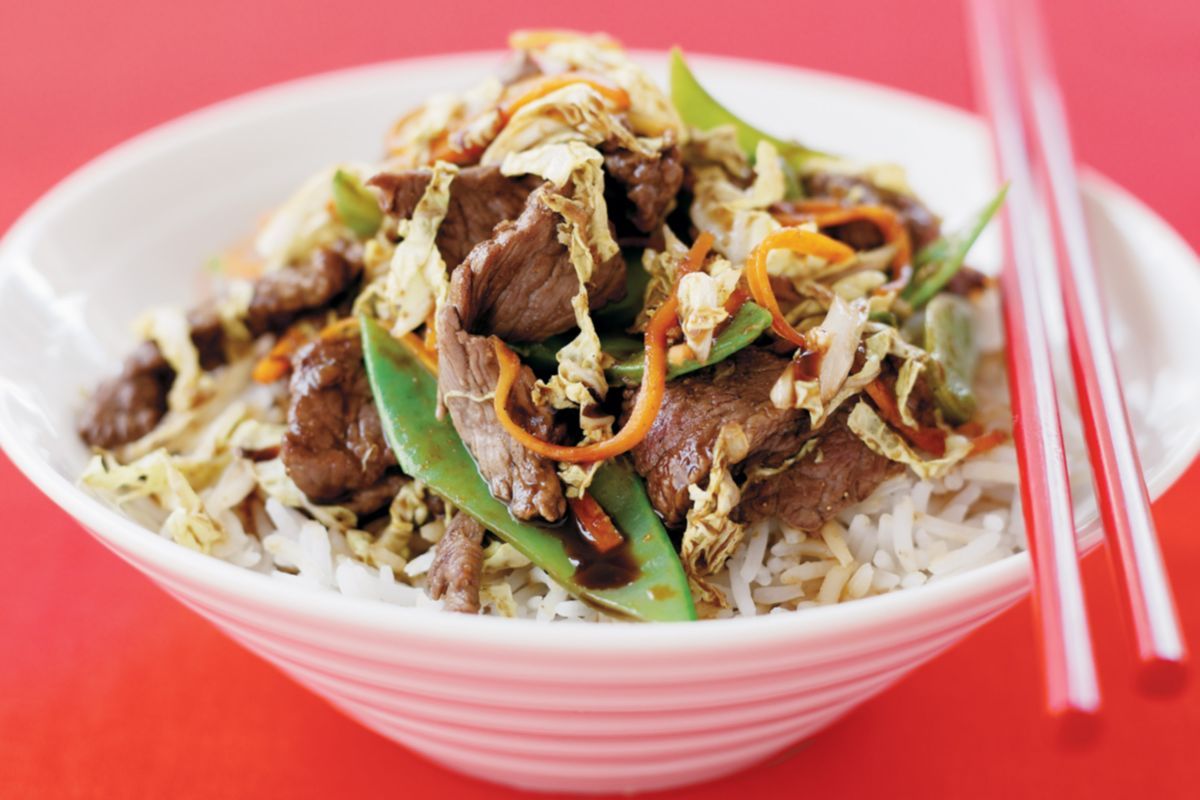Embark on a culinary journey through vibrant Asian flavors with this exploration of nut-free stir-fry recipes. Discover a world of textures and tastes, from the crisp snap of fresh vegetables to the savory depth of expertly balanced sauces. Learn how to master the art of wok hei, achieving that signature smoky char, and adapt recipes to suit various dietary needs. Prepare to be inspired by the colorful array of ingredients and the satisfying simplicity of these delicious and healthy meals.
This guide delves into the heart of Asian-inspired cooking, offering a comprehensive look at ingredient selection, flavor profile creation, and essential techniques for achieving stir-fry perfection. We’ll explore a diverse range of vegetables, highlighting their unique characteristics and culinary applications. You’ll learn to confidently navigate the nuances of sweet, sour, salty, and spicy flavor combinations, and master the art of adapting recipes to accommodate various dietary restrictions, ensuring everyone can enjoy these delightful dishes.
Essential Techniques for Nut-Free Stir-Fry Success

Mastering the art of the stir-fry hinges on a few key techniques that elevate a simple dish into a culinary masterpiece. Proper preparation and execution are paramount to achieving that coveted wok hei, the smoky, slightly charred flavor that defines a truly authentic stir-fry. This section will delve into the essential steps to guarantee your nut-free stir-fry is a resounding success.
Ingredient Preparation for Optimal Results
Meticulous ingredient preparation is the cornerstone of any successful stir-fry. Vegetables should be uniformly sliced or diced to ensure even cooking; a mix of textures—crisp-tender broccoli florets alongside thinly sliced bell peppers—adds visual appeal and textural complexity. Proteins, whether tofu, chicken, shrimp, or beef, benefit immensely from a quick marinade. A simple marinade, perhaps soy sauce, ginger, and garlic, infuses the protein with flavor and tenderizes it, resulting in a more succulent and flavorful final product. Prepping ingredients in advance streamlines the cooking process, allowing you to focus on the dynamic choreography of the stir-fry itself. Imagine vibrant, emerald green broccoli florets, perfectly julienned carrots, and glistening pieces of marinated chicken, all ready to dance in the hot wok.
Wok Hei Technique: Achieving the Smoky Char
Wok hei, the soul of a stir-fry, is a result of high heat and the constant motion of the ingredients within the wok. The process begins with a fiercely hot wok, ideally preheated until a drop of water evaporates instantly. Add your oil, allowing it to shimmer before adding the protein. Stir-fry the protein until it’s nearly cooked, then remove it from the wok. Next, add your vegetables, stir-frying them quickly until they are tender-crisp. Crucially, maintain constant motion, ensuring that each piece of ingredient makes contact with the incredibly hot wok surface. This creates a subtle char, adding depth of flavor and a desirable smoky aroma. Finally, return the protein to the wok, combining it with the vegetables and any sauce. A brief toss ensures everything is heated through and coated in the sauce. The result is a dish imbued with the distinctive smoky aroma and slightly charred edges that characterize authentic wok hei. The final product is not just cooked; it’s imbued with a depth of flavor that’s impossible to replicate with lower heat.
Common Mistakes to Avoid and Their Solutions
Several common pitfalls can undermine a nut-free stir-fry. Understanding these mistakes and their solutions ensures a consistently delicious result.
- Overcrowding the wok: Adding too many ingredients at once lowers the temperature, resulting in steaming rather than stir-frying. The solution is to stir-fry ingredients in batches, ensuring each batch has ample space to brown and develop that coveted wok hei.
- Underestimating cooking time: Stir-fries rely on speed and high heat. Undercooked vegetables or protein can lead to a less satisfying experience. The solution is to ensure ingredients are cooked through while still maintaining their crispness and vibrant colors. Proper timing and constant attention are key.
- Using low heat: Low heat leads to soggy vegetables and bland flavors. The solution is to use high heat from the outset, ensuring the wok is sufficiently hot before adding ingredients. This creates the ideal environment for developing wok hei and maintaining the vibrant color and texture of the vegetables.
- Ignoring sauce consistency: A poorly balanced sauce can ruin the entire dish. Too thick a sauce can coat ingredients unevenly, while a too-thin sauce lacks the body to properly cling to the ingredients. The solution is to create a sauce with the right balance of starch (cornstarch, arrowroot powder) and liquid to achieve the desired consistency. Adjusting this balance allows for a perfectly coating sauce that enhances, not overwhelms, the dish’s flavors.
Recipe Ideas
These three Asian-inspired nut-free stir-fry recipes offer a vibrant array of flavors and textures, showcasing the versatility of this cooking method. Each recipe is designed to be both delicious and nutritionally balanced, providing a satisfying and healthy meal. Careful attention has been paid to ensure that no nuts or nut products are included, making these recipes suitable for those with nut allergies.
Sweet and Sour Chicken Stir-Fry
This classic stir-fry bursts with sweet and tangy flavors, offering a delightful balance of savory and sweet. The vibrant colors and contrasting textures make it visually appealing.
- Marinate 1 lb boneless, skinless chicken breast in 2 tbsp soy sauce, 1 tbsp rice vinegar, and 1 tsp cornstarch for 15 minutes.
- Stir-fry the marinated chicken in 1 tbsp oil until cooked through.
- Add 1 cup broccoli florets, 1 red bell pepper (sliced), and 1/2 cup sliced carrots and stir-fry for 3-5 minutes.
- In a separate bowl, whisk together 1/4 cup soy sauce, 1/4 cup rice vinegar, 2 tbsp sugar, 1 tbsp cornstarch, and 1/4 cup water.
- Pour the sauce over the chicken and vegetables and stir-fry until the sauce thickens.
- Garnish with chopped green onions before serving.
Spicy Tofu and Vegetable Stir-Fry
This vegetarian stir-fry is packed with bold flavors and a delightful kick of spice. The combination of textures, from the firm tofu to the crisp vegetables, creates a satisfying culinary experience.
- Press 1 block (14 oz) firm tofu to remove excess water and cut into cubes.
- Toss the tofu with 1 tbsp soy sauce, 1 tsp cornstarch, and 1/2 tsp ground red pepper.
- Stir-fry the tofu in 1 tbsp oil until golden brown and slightly crispy.
- Add 1 cup broccoli florets, 1/2 cup sliced mushrooms, 1/2 cup snow peas, and 1/4 cup chopped scallions. Stir-fry for 3-5 minutes.
- In a small bowl, whisk together 2 tbsp soy sauce, 1 tbsp rice vinegar, 1 tsp sesame oil, and 1 tsp brown sugar.
- Pour the sauce over the tofu and vegetables and stir-fry until the sauce is evenly coated.
- Serve over rice and garnish with sesame seeds.
Garlic Shrimp and Bok Choy Stir-Fry
This light and flavorful stir-fry is a quick and easy weeknight meal. The vibrant green of the bok choy contrasts beautifully with the pink shrimp, creating a visually stunning dish.
- Peel and devein 1 lb shrimp.
- In a bowl, toss the shrimp with 1 tbsp soy sauce, 1 tsp cornstarch, and 1/2 tsp garlic powder.
- Stir-fry the shrimp in 1 tbsp oil until pink and cooked through.
- Add 1 bunch of bok choy (chopped) and 2 cloves of minced garlic. Stir-fry for 2-3 minutes until the bok choy is wilted but still crisp.
- Drizzle with 1 tbsp sesame oil and season with salt and pepper to taste.
- Serve immediately over rice or noodles.
Nutritional Information (Per Serving)
| Recipe Name | Calories | Protein (g) | Carbohydrates (g) | Fat (g) |
|---|---|---|---|---|
| Sweet and Sour Chicken | 350 | 30 | 35 | 10 |
| Spicy Tofu and Vegetable | 280 | 25 | 30 | 12 |
| Garlic Shrimp and Bok Choy | 250 | 28 | 15 | 10 |
Adapting Recipes for Dietary Restrictions (Beyond Nut-Free)
Creating delicious and vibrant Asian-inspired stir-fries that cater to various dietary needs requires a thoughtful approach to ingredient substitution. This section explores adapting our nut-free recipes to accommodate vegetarian, vegan, and gluten-free diets, ensuring everyone can enjoy these flavorful dishes. We will focus on maintaining both the authentic taste and satisfying texture of the stir-fries while adhering to specific dietary requirements.
Adapting Stir-Fry Recipes for Diverse Diets involves understanding the core components of a stir-fry and finding suitable replacements for ingredients that may not be suitable for all diets. This includes considering protein sources, thickening agents, and sauces.
Vegetarian Adaptations
Many traditional Asian stir-fries already incorporate vegetarian components, such as tofu, mushrooms, and various vegetables. To make a recipe fully vegetarian, simply omit any meat or seafood ingredients. Focus on increasing the volume and variety of vegetables for a hearty and satisfying meal. Consider adding extra firm tofu, pressed to remove excess moisture, for a more substantial protein source. Alternatively, hearty mushrooms like shiitake or oyster mushrooms can provide a meaty texture and umami flavor. Imagine a vibrant stir-fry bursting with the colors of bell peppers, broccoli florets, and vibrant green bok choy, all complemented by the earthy notes of shiitake mushrooms and the subtle sweetness of carrots.
Vegan Adaptations
Building upon vegetarian adaptations, vegan stir-fries require the removal of any animal products, including honey or fish sauce. Many traditional sauces contain fish sauce or oyster sauce; these can be replaced with soy sauce, tamari (gluten-free soy sauce), or a combination of coconut aminos and rice vinegar for a similar umami depth. Vegan Worcestershire sauce can also add a savory depth. For a richer texture and mouthfeel, consider using silken tofu or incorporating a variety of beans and lentils for added protein and fiber. Visualize a deeply colored vegan stir-fry, the dark soy sauce creating a rich glaze over vibrant, colorful vegetables and hearty lentils, a picture of both health and flavor.
Gluten-Free Adaptations
Gluten-free stir-fries often require careful attention to the sauces and seasonings used. Many soy sauces contain wheat, so tamari (naturally gluten-free soy sauce) or coconut aminos are excellent alternatives. Check all ingredient labels to ensure they are certified gluten-free, as cross-contamination can occur during processing. For thickening, instead of relying on wheat-based flour or cornstarch, use arrowroot powder, tapioca starch, or even finely pureed vegetables to create a natural thickening agent. A gluten-free stir-fry can be just as vibrant and flavorful, a testament to the adaptability of this culinary style.
Ingredient Substitutions for Dietary Restrictions
Understanding suitable substitutes is key to successfully adapting stir-fry recipes. The following table provides a helpful guide:
| Ingredient | Dietary Restriction | Suitable Substitute | Notes |
|---|---|---|---|
| Soy Sauce | Gluten-Free | Tamari, Coconut Aminos | Tamari is naturally gluten-free; coconut aminos offer a slightly sweeter profile. |
| Oyster Sauce | Vegan, Vegetarian | Soy Sauce, Mushroom Sauce | Mushroom sauce provides a similar umami flavor. |
| Chicken Broth | Vegan | Vegetable Broth | Ensure the broth is free of animal products. |
| Honey | Vegan | Maple Syrup, Agave Nectar | Adjust sweetness to taste. |
From the vibrant colors of perfectly seared vegetables to the aromatic symphony of balanced flavors, mastering the art of the Asian-inspired nut-free stir-fry opens a world of culinary possibilities. This guide has equipped you with the knowledge and techniques to create stunning, healthy, and delicious meals that cater to a variety of dietary needs. Experiment with different flavor profiles, explore diverse vegetables, and most importantly, enjoy the creative process of crafting your own unique stir-fry masterpieces. The journey of flavor awaits!
General Inquiries
What are some good substitutes for soy sauce in a nut-free stir-fry?
Coconut aminos, tamari (if gluten-free is not a concern), or even a reduced balsamic vinegar can provide savory depth similar to soy sauce.
How can I prevent my stir-fry vegetables from becoming mushy?
Ensure your wok or pan is extremely hot before adding vegetables. Stir-fry quickly and don’t overcrowd the pan; work in batches if necessary.
Can I use frozen vegetables in a stir-fry?
Yes, but be sure to thaw them completely and pat them dry before adding them to the hot wok to prevent excess moisture.
How long can I store leftover stir-fry?
Store leftovers in an airtight container in the refrigerator for up to 3-4 days. Reheat gently over medium heat.


